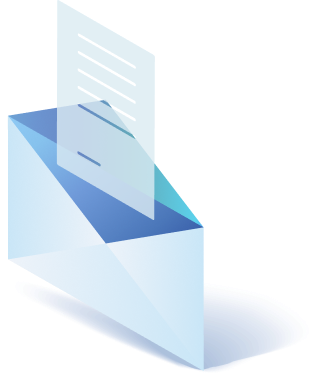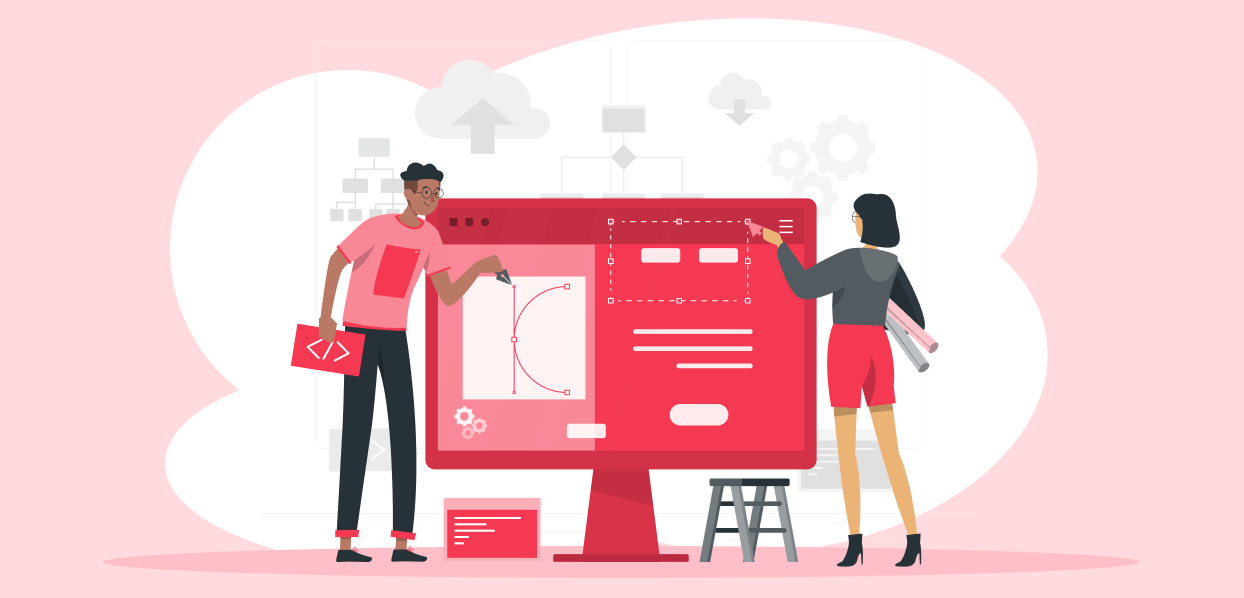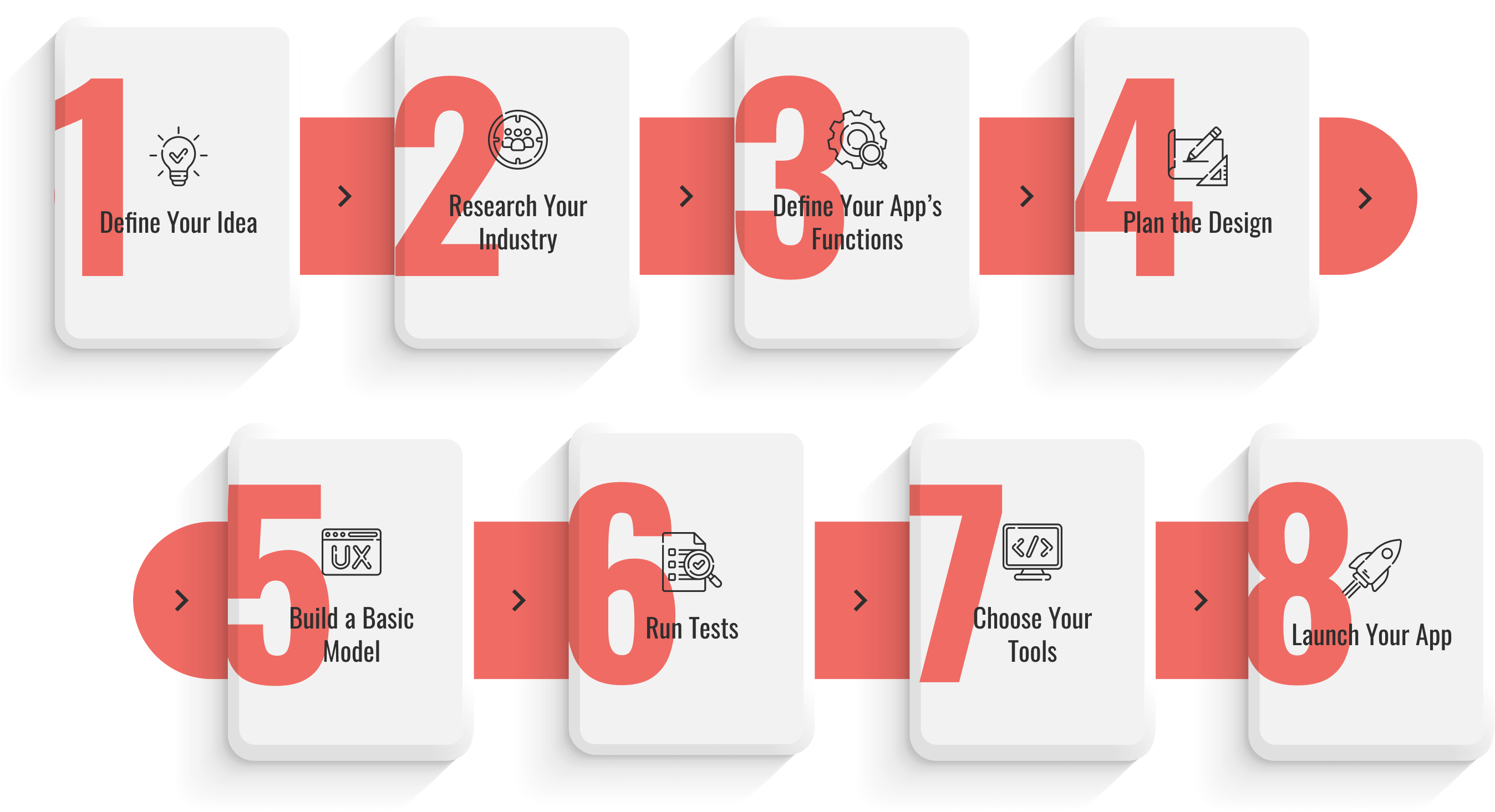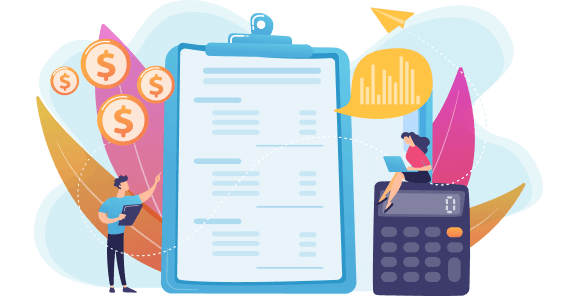Now that you understand what a web app is, it’s time to ask the next logical question: What is the process of developing a web app?
While every web app development company uses its own process, we think the one we’ve outlined here works best. In this part of the web application development guide, we’ll shine a light on every step of creating a mid-size web app, starting from analyses and mockup design and going to web app development and deployment.
In a later section, we will look in detail at the technology, including frameworks and programming languages. Before we get to that, here is the process you will probably face with when decide to build custom web application development.
1. Define Idea
Most web apps begin as solutions for specific problems. At our web application development agency, we typically ask the following questions: What business problem do you want to solve? What is the biggest obstacle to your company’s growth and success? What problems do your industry colleagues complain about?
The answers to these questions will tell you where to focus. Many people think they need to come up with an app that is unique and groundbreaking, but that isn’t true. Some of the most successful apps are those that simplify routine procedures or make it easier to perform basic tasks.
2. Research Industry
Before you launch your idea, make sure you have customers for it. Will your idea appeal to other people in your industry or line of work? Market research is critical. Figure out who your target buyer is, and think about how you’ll market the app to them. As your website application development company, we’ll work with you to refine this plan.
3. Define App’s Functions
It’s important to define exactly what your app does. When you can explain it in simple terms, you know how to market it. Explain how your app stands out from other, competing apps or other solutions currently available. How does your app solve a common problem, and how does it do this better than anything else your customers might use? While you are developing this definition, think about the basic functions your app needs.
4. Plan the Design
As a web app development company, we know how important good design is. We understand you’re not a professional designer or artist. Despite this, you should know how you want your app to look. A basic sketch is all we need to get started.
The design may go through changes as we develop the app, but we want to see your basic idea and build on that. What do you want users to see when they open the app? Consider which colors, logos and images you want to use.
Design includes workflow and navigation. We can show you how to create a web app with seamless navigation and integration of other technologies.
5. Build a Basic Model
Once we have a basic design and have determined the functions your app needs, our web app development company begins by building working models. Known as wireframes, these are computer-generated sketches that give you the first impression of your app.
After refining the wireframe sketch, we build a prototype. This is the first working model of your app. It looks, feels and performs just like a fully-fledged app, but it has limited functions.
Building a web app requires the right tools. At this stage, the technologies we use are mostly wireframe builders, including Sketch, InVision Studio or Adobe XD.
6. Run Tests
A test run of your app will help you see what you should keep, what you should get rid of, and what you can tweak to make your app work well.
Who should your testers be? Think about the people you’ve designed the app for. Give the prototype to a handful of people in your test market. Include your friends, colleagues, and others who will give you honest reviews.
Once you get some responses, use them to make improvements to your app. User reviews are the best way to test your app in the real world.
7. Choose Your Tools
In this section, we’re going to take a closer look at the technology behind a web app. To create a fully functional app, you need advanced technologies at the back end and front end. Following are the main frameworks and other technologies we rely on as a web application development agency.
Front-End, Client-Side Programming Language
Coders and developers have relied on the following tools for decades. They are proven, tested and continually updated to be the leading web app development languages.
JavaScript
This is the primary programming language used to build web apps. It is the most trusted tool for installing client-side functions into a web app, website or other platform.
JavaScript allows developers to build dynamic websites with user-friendly details. It’s the language behind the features we expect from a website or web app, from buttons to links to navigation bars.
In recent years, JavaScript has evolved to keep up with innovative technologies, and it is a reliable, versatile tool.
HTML
One of the oldest programming languages, HTML is another dependable item in every developer’s toolkit. This flexible coding language allows web app creators to design pages with appealing layouts, graphics, video streaming and other features.
Almost any functioning website you visit was built with HTML markups. It is a rich source of useful, time-tested building tools.
CSS
Like HTML and JavaScript, this is a standard, trusted language that has been around for decades. Developers rely on CSS to bring their most creative visions to life. It’s the language that makes colors, fonts, graphics and other visual elements show on a website. When you want beautiful design with a highly functional app, you use CSS.
Back-End, Server-Side Programming Languages
These are the frameworks we will use to add back-end functions to a web app. Back-end functions include complex programs, databases and APIs. They allow databases to communicate with each other, ease sharing between servers, and manage user interactions. They also manage safety protocols, security authentications and other important privacy functions.
The most widely used languages for these functions include Python, Java, Ruby on Rails and PHP. Our web application company relies on all of them.
Python
This feature-rich, server-side scripting language has emerged as the premier framework for building web apps of all sizes and functions. It is a versatile language that developers consider one of the best in the industry.
PHP
This is one of the most trusted back-end programming languages. It is a sophisticated, fully developed language used to build interactive components on a website or web application. It works well with other languages and is an excellent choice for any developer. Its acronym comes from its earlier name, which was Personal Home Pages.
Ruby on Rails
This language works particularly well with databases and is ideal for small, task-focused web apps. It makes building a web app much easier, and it comes with ample tech support.
Asp.Net
This free, open source framework was developed by Microsoft. It works with C# and other coding languages, so it makes web app development easy, even for coders who don’t use Python.
Relational Databases
Every web app needs a database to hold data and free up space to run its features. The languages used to build databases are primarily query languages that can form questions, search databases and retrieve information.
Structured Query Language (SQL), as its name implies, is the primary coding language developers use to build querying tables. It comes with built-in tools that include MySQL, SQL Server and PostgreSQL. It allows a web app creator to form organized collections called relational databases.
Servers
A server retrieves information and guides a user through a web application. It is the heart of what a computer does. The server processes requests and delivers them to another computer. There are many types of servers, and the one you choose for your web app depends on the power and functionality you need. The best web servers include Apache, LightSpeed, WP Farm and Nginx.
APIs
APIs allow different software systems to communicate with each other.
To get a sense of how APIs work, think about buying something online. When you make a purchase, an API sends a message to your bank or credit card. Another API returns the information and signals to the shopping site that it’s fine to process the payment.
There are several types of API, including open API and private API. Custom APIs will give your app unique features no competitor has. As a web application development company, we have extensive experience creating custom APIs.
Frameworks
A framework is a set of libraries and tools that make building a web app easier. You still need high-level programming skills, but a framework can manage the routine coding tasks. Most frameworks for web apps use the Model View Controller form of architecture.
Among the best of these frameworks are:
- Angular JS: This allows fast building of front-end features for single-page applications.
- React JS: This front-end library works with JavaScript to build user interfaces.
- Vue JS: Web app creators who currently work in HTML, CSS and JavaScript can quickly learn the ins and outs of Vue JS.
- Laravel: Laravel is a web application framework that enhances creativity and the creation of elegant web designs.
- Django: A high-level Python framework that enhances fast deployment and clean, streamlined designs.
This phase of web application development can be confusing. If you’re feeling overwhelmed by the technology choices out there, remember that you don’t have to decide immediately. Our web development services include a technical consultation to determine the best frameworks and languages for your app.
Once we select a framework, we move to specific coding, libraries, languages and other tools. The choices will depend on the specific functionality of your app and the preferences of your web application company. As a professional web application company, our team includes experts in all the major languages and frameworks.
Once we select a framework, we move to specific coding, libraries, languages and other tools. The choices will depend on the specific functionality of your app and the preferences of your web application company. As a professional web application company, our team includes experts in all the major languages and frameworks.
8. Choose a Host Server
Every web app needs a host server. There are dozens of available web host servers, and they all have the capabilities you need for your web app development service.
The most widely used, reliable hosts include Bluehost, HostGator, WP Engine, GoDaddy and IONOS. Once you have chosen a host server, set up a cloud provider. You can choose Microsoft’s Azure, Google Cloud or another provider of your choice. As your custom web application development company, we can help you choose the best providers
9. Launch Your App
Launching your app is the final, long-awaited step in the process. Before you launch, be sure to test your app on a testing site. Our web app development service includes testing and all updates.
Congratulations. You’ve created and launched a new app that will transform your business.
Work with a Knowledgeable Web App Development Company
We hope this guide to web application development has been helpful. A successful app begins with a precise plan how to implement an idea that will be not only alive but cost-effective. Once we have determined this, our website application development company can begin with a basic MVP and a mockups design that addresses your business’s challenges.
Building a web app can be an exciting new business venture, and we want to make it as enjoyable as possible. When we provide custom web app development services, we ensure a smooth, transparent collaboration, and we update you during each step of the process.
When choose web application development company, make sure that it provide portfolio that represents experience as a global website application development company with clear website application development process.
Our portfolio includes custom web application development services for small startups, nonprofit organizations and large, multinational companies.
We are an experienced web app development agency, and we have created powerful, fully functional apps for many businesses. If you’re ready to build and launch a custom web app, contact our web application development agency to get started.
Get Expert Web App Development Services
Are you ready to build a custom app? If want custom web application development services, contact us.
Let’s Talk



